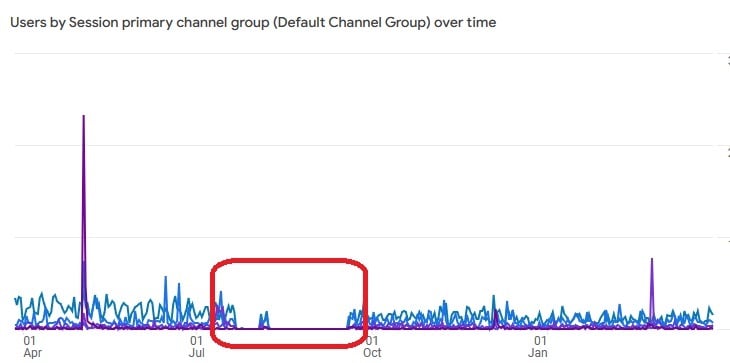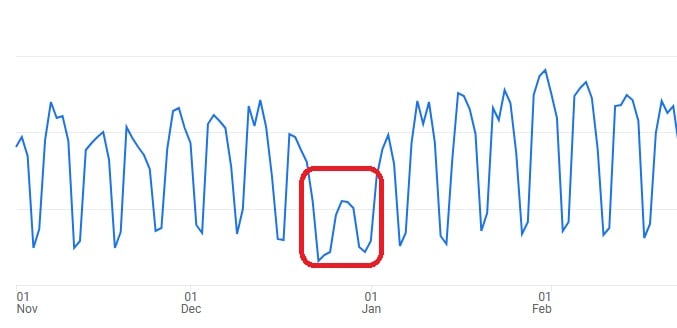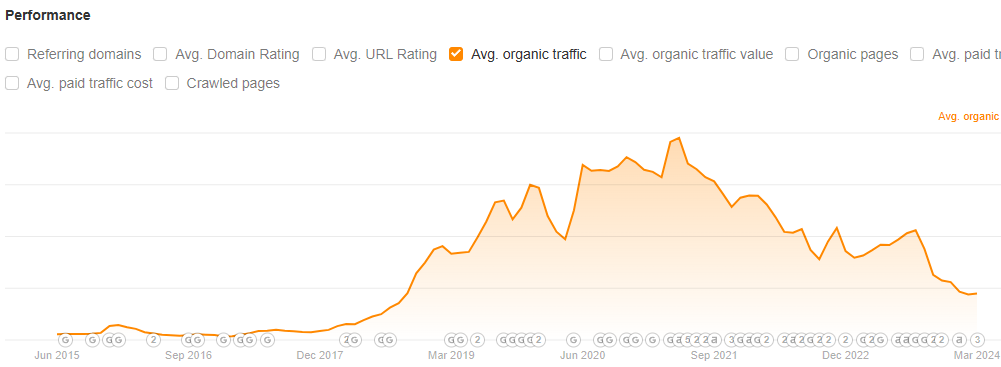Where Did My Traffic Go? Hint: It Wasn’t an Algorithm Update
(Editorial note: I originally wrote this post over on the Hit Subscribe blog. I’ll be cross-posting anything I think this audience might find interesting and also started a SubStack to which I’ll syndicate marketing-related content.)
If you were to take a stroll through Hit Subscribe’s offering page, you’d see that we now have a first-class “traffic recovery” offering. We added this because of the frequency with which we field the question, “Why is my [usually organic] traffic declining?!”
In fact, we field that question so frequently that I’m writing this blog post to distribute to friends and prospects to help with self-diagnosis, potentially saving you some money on a possible engagement. So if that’s what brought you here, sorry about your traffic. But don’t worry. We’ll get it sorted.
In this post, I’ll discuss the most common reasons we see for lost traffic, describe the decline pattern you would expect to see if these things were happening, and explain how to start remediating the issue.
First Things First: Forget About “The Algorithm”
One of my all-time favorite books is Joseph Heller’s Catch 22, wherein he amuses the reader with assorted, specific paradoxes. The military grounds “crazy” fighter pilots and allows sane ones to fly, and they evaluate craziness by whether or not the pilot wants to fly. Anyone who doesn’t want to risk their life flying is non-crazy, and therefore must fly.
Of course, paradox exists beyond the novel. Probably preceding it and in a nod to the importance of status illegibility, Groucho Marx once quipped, “I refuse to join any club that would have me as a member.”
I’ll offer one another paradox for your consideration:
“The algorithm” only punishes those who go out of their way to avoid punishment.
In less quippy terms, if you’ve been generating content in good faith without thinking about “the algorithm,” you’re safe. Hit Subscribe, for instance, has managed analytics for more companies than I can count at this point. And we have never seen an algorithm update have any impact on anyone. We honestly don’t even pay attention to them.
Scumbag and Non-Scumbag SEO
I personally divide the SEO world into two camps: scumbag SEO and non-scumbag SEO. Our non-scumbag SEO methodology consists primarily of two steps:
- Figure out what questions people are asking the search engine and answer those questions.
- Do it on a site that doesn’t suck to visit.
Luckily, if you’ve been creating content in good faith and earning search traffic, you have, yourself, been executing this process. This is, almost without exception, the case for everyone that asks about traffic declines.
Scumbag SEO, on the other hand, adds various additional steps to the process:
- Spam comment sections with nonsense that talks about your site.
- Stuff keywords into your prose until your reader thinks they’re having a stroke.
- Pay an “SEO firm” $5 per hour to do things you’d prefer not to know about.
- Hack into abandoned WordPress sites and add links to your domain.
- Conduct “SEO heists” using generative AI.
Scumbag SEO is a constant game of taking cost shortcuts and avoiding punishment, always staying one jump ahead of the breadline. And scumbag SEOs are who Google punishes with its algorithm updates.
If you’re doing scumbag SEO, trust me, you know it, and you know the risks. You don’t do that kind of thing by accident.
(As an aside, a lot of SEO conusltants will likely take issue with what I’m saying here. But they do so from a position of extreme motivated reasoning. Their livelihood depends on you believing the only way to avoid Google’s wrath is to pay an SEO consultant to execute an endless punch list of billable minutiae.)
So if it wasn’t the algorithm, where did your traffic go? Let’s take a look.
The Non-Issues
Here’s a quick caveat about the rest of this post before proceeding. When I talk about what the decline will commonly look like, I mean just that: commonly. There can always be edge cases that don’t follow the pattern.
With that lawyer-speak in the books, let’s talk traffic declining. Before looking at legitimate sources of traffic decline, let’s look at some things we see that aren’t actually problems.
1. Your Analytics Tool Is Broken
It might surprise you to learn how often the “problem” isn’t with the site or rankings but with the analytics tool itself. I’ve lost track of how many times over the years someone has, in a panic, asked why their traffic is all gone, only to experience great relief upon learning, no, it’s still there. Google Analytics (or whatever) is just broken, so you’re flying blind.
Lest you feel bad, here’s a screenshot of Hit Subscribe’s GA4 traffic over the last 12 months.

We don’t depend on the website as a source of lead generation, so we don’t pay a lot of attention to hitsubscribe.com’s analytics. If you doubt that, check out this two-ish month window where we “had zero traffic.”
Now, imagine the problem wasn’t yet fixed and we first noticed this flatline trend back in September. You could understand someone panicking a little.
But ask yourself if it seems likely that a normally functioning website would suddenly drop to zero traffic. I mean, I had personally visited the site, so it couldn’t actually be zero. So if you see something like this, take a breath, since the most likely situation is that you need to fix your analytics setup and your traffic will “come back.”
What You’d Commonly See: A sudden total, or near-total drop in traffic that stays at or around zero.
What To Do: Talk to whoever administers it about reconnecting your analytics tool.
2. Normal Seasonality
Next up in the non-issue category is seasonality. This is any traffic dip that you could expect because of what’s going on in the world.
For instance, in B2B settings, people tend to do fewer business-y things (such as visiting your website) at certain times of year: holidays, back to school, summer vacations, etc. All of those things can have an impact.
Take a look at this anonymized organic traffic graph, for instance, noting the dates.

What do you suppose happened there? A catastrophic traffic fall-off? Or, “Hey, it’s the week between Christmas and New Year, and very few people are doing business things.”
Christmas is an easy one, but seasonality occurs in all sorts of patterns (including the troughs above and in almost every B2B organic graph that represent weekends). So one of the first things that you should check when you notice a traffic drop is whether it might be attributable to world events.
What You’d Commonly See: A dip in traffic that followed a repeatable pattern.
What To Do: Form a hypothesis about seasonality, and then check to see whether you’ve lost traffic in this fashion in the past.
3. Sometimes It Be Like That
The last thing that I’ll mention is that traffic to your site is more of a game of aggregates and patterns than a precise daily march upwards in volume. In other words, you might have 600 visitors on Monday, only 500 on Tuesday, and 600 again on Wednesday for reasons that you’ll never discover.
When you’re looking at a channel with significant traffic, you have to take care not to focus too narrowly and thus detect phantom trends. If you fall into this trap, then you’d panic every Saturday about the graph in the last section.
Generally, we advise clients to look at a channel’s monthly production, which tends to provide enough data points to smooth out inexplicable anomalies and the vagaries of life. And even at the month level, occasionally you’ll see a temporary dip in an otherwise upward trendline. And you’ll probably never discover why, exactly.
What You’d Commonly See: A dip in traffic too new to have statistical significance.
What To Do: Chart out the trendline of traffic over the past few months and keep your eye on it for a few weeks to ensure it reverts to the mean.
Normal Wear and Tear
Alright. With the low-effort stuff out of the way, let’s move on to actual, meaningful traffic declines and what to do about them.
I’m calling this next category “normal wear and tear” because it’s what happens naturally, when you’re not doing anything “wrong” (by which I mean something that would materially impact your standing with Google and the search experience). To understand this, you need to axiomatically accept that when you do nothing to your site, your traffic will naturally decay over time. You can read more about that here, if you don’t want to just take my word for it.
4. Gradual Traffic Decay
Here’s a screenshot of Ahrefs’ approximation of organic traffic to a site. This site published organic-traffic-targeting content from 2017 until the middle of 2019 and then stopped. And this graph is a textbook example of what you should expect in that situation.

Any organic content that you publish will have a lead time before it starts to earn traffic. As a result, sites exhibit a seemingly curious property once you turn off the content faucet: they continue to grow for a while. (This often creates the illusion among site owners that organic traffic is more durable than it is.)
In the graph above, the site did indeed continue to grow for a while before eventually plateauing at the beginning of 2021 and starting a gradual decline. At least, that’s what it looks like in aggregate. In reality, decay for a given article starts 12 to 18 months after publication, and what actually happened at the plateau was that the site hit a tipping point where the decay of early articles caught up to the growth of more recent ones.
Usually when people ask me about their traffic and this is the situation, they’re asking when they’re in a steady state of decline (e.g., they’d ask at the beginning of 2022 in this graph). So they stopped producing much content a while ago, observed a plateau and decline, but hoped the traffic would “come back” after a while.
It’s not coming back, my friend. You’re going to have to reinvest in the channel if you want to regain your traffic.
What You’d Commonly See: A gradual decline in the low single-digit percents (assuming little to no new content).
What To Do: Start executing new content, or at least refreshing existing content.
5. Top-Heavy Traffic Decay
For this traffic decline, the same mechanics as the last one are at play, except that the nature of the traffic is a little different. In the graph above, the site had dozens of articles, the overwhelming majority of which were producing a decent amount of traffic. This is the healthy, expected situation if you’re intentionally targeting organic as a traffic or lead gen channel.
But there’s another common situation among site owners, particularly those who have stumbled into organic traffic rather than intentionally seeking it. This is usually among the set of people that journal-blog and engage in audience building (e.g., my consulting site, DaedTech). And the situation is that, out of say, 100 articles, three articles will account for 95% of their organic traffic.
When this is the case, those articles are still subject to the vagaries of traffic decay. But that decay tends to look much “lumpier” and sudden. If a single article is bringing half of the traffic to a site and that article declines in rankings, you might lose a quarter of your site traffic in a week.
Luckily, this is pretty easy to diagnose, since you can simply look at the traffic individually to the traffic earners and see where the bleeding is happening.
What You’d Commonly See: A sharper decline and plateau in traffic.
What To Do: Refresh the articles in the short term and try to make the channel less top heavy in the longer term.
6. Topical Interest Decline
This last one under natural wear and tear is probably the biggest bummer for any site owner. In your analytics dashboard, it will look much like the gradual traffic decay pattern, if a little sharper in downward slope. But it has much different implications.
This occurs when the broader internet is losing interest in what you’ve been posting about.
With normal traffic decay, you tend to lose traffic to other content creators targeting similar searches and competing with you for their visits. Topical interest remains strong, but you have more trouble reaching them unless you update your content. But with interest decline, the searchers themselves go away.
For instance, let’s say you’d created a site dedicated to the erstwhile social media platform Google Plus. You’d have seen a gradual traffic decline over time without new content, but you’d even see it if you were producing new content. People stop googling and reading about the term, so the traffic simply isn’t there.
What You’d Commonly See: A gradual decline in the low single-digit percents, new content or not.
What To Do: You probably have bigger problems than generating traffic.
Technical and Site Issues
For this last set, I’ll cover some common scenarios where there’s some active, likely inadvertent self-sabotage happening. Please bear in mind this is not, and is not intended to be, an exhaustive list—just some common ones that we see.
If, for instance, you queued up some scumbag SEO and made Google legitimately unhappy with your site, you would also lose traffic. But I’m not covering that here, under the fundamental premise of the post (that you’ve been acting in good faith).
7. You Unpublished Some Content
Don’t laugh. Accidentally unpublishing content happens way more frequently than you’d think.
For instance, about a month ago, I deleted an inactive user from our CMS. It turned out, for reasons that cost a web dev agency any future business of mine, that this user was inexplicably the author of all of our landing pages except the blog. So, before we reverted it to a valid state, our site briefly had nothing on it except the blog.
Now we obviously noticed this relatively quickly. But we probably wouldn’t have, had this user only had the byline on a few two-year-old blog posts. In that scenario, we’d simply have lost some traffic to formerly valid URLs now throwing 404s.
If this happens, you’ll generally see a sharp but noncatastrophic dip in traffic. So one of the first things I’d do is look for missing articles. (Explaining how to do this is a topic for another day—let me know if you’re interested.)
What You’d Commonly See: A sharp, noncatastrophic decline and then plateau.
What To Do: Republish the content and request indexing.
8. A Recent Migration or Site Redesign Created Technical SEO Problems
By far the most frequent and tragic loss of traffic that we see arises from some kind of site overhaul or migration. I’m not exaggerating when I’d ballpark that our clients have collectively lost tens of millions of visitors over the last seven years to this.
There are far too many things that can go wrong for me to enumerate them here. But they tend to revolve broadly around content migration, site performance, improper setup of SEO artifacts (sitemaps, robots.txt, etc.), and improper redirection of content.
Luckily, this is extremely easy to diagnose, at least at the holistic level. You’re obviously going to know if you recently executed a site overhaul or domain name change.
Fixing it, however, can really run the gamut in terms of effort and complexity.
What You’d Commonly See: A sharp decline and then variability or fluctuation.
What To Do: If you don’t know where to start, ask folks in your network for advice or a referral. Don’t DIY this.
9. Something Acute Is Wrong With Your Site
In a way, this next situation is a generalized version of the last one. If there is something substantially wrong with your site, recent overhaul or not, it can catastrophically impact your traffic.
Like the last situation, this can really run the gamut: hosting issues, site security issues, server errors, a CMS bug, and many reasons beyond that. But the common thread is that something pretty major is going on with your site.
A lot of times this will cause problems beyond a drop in traffic, but not necessarily. Or it might just be that nobody is reporting those problems to you. Either way, if you see a large, sudden drop in traffic and it’s not a faulty analytics setup and you haven’t recently redone the site, the first thing to do is start troubleshooting for site problems.
What You’d Commonly See: A catastrophic decline and then plateau.
What To Do: Navigate to the site yourself and start at least doing some manual QA to see if there’s anything obviously wrong.
10. Something Subtle Is Wrong With Your Site
This last traffic loss scenario is probably the most bedeviling for all parties involved. If there’s something catastrophically wrong with your site, that’s awful, but at least it’s obvious what’s wrong and it’s all hands on deck to fix. But what about when there’s something seemingly subtle or unnoticeable tanking your traffic, like some kind of digital planet X?
Examples of this that we see include CMS SEO misconfiguration, slow page loading, bad user experience, searcher-unfriendly page layouts, and other similar arcana (for most). In these situations, sites still earn traffic and it can be extremely hard to know if anything is wrong, let alone what.
There’s a decent chance that someone with these problems would never notice them. After all, they might experience steady traffic growth, in spite of chronically underperforming where they should rank. Or if the subtle issue cropped up more recently, it might take the form of gradual stagnation or decline, followed by underwhelming growth.
We have a methodology for this that would be hard to DIY. It involves assessing how an article should perform and then looking for systemic underperformance.
Without that, DIYers generally need to rely on (noisy) SEO tools for site audits. That can be a frustrating path, but it’s a decent starting point at least, if you think your site is underperforming.
What You’d Commonly See: A medium to gradual decline and then plateau or underwhelming growth.
What To Do: Use one or more SEO tools to audit your site, start addressing issues, and see if things improve.
Troubleshooting Traffic Drops, Philosophically
I’ve laid out a laundry list of common situations that we see, how to recognize them, and what to do next. But I’d like to close with a bit of advice that applies to any and all situations, even ones not covered here.
Deconstruct the problem.
Traffic to your site doesn’t come holistically. It comes via individual URLs.
So start by breaking down the traffic to each individual URL. This will allow you to isolate the source of decline, which will in turn make for easier troubleshooting.
Did all of the decline come from one URL? Probably something wrong with that URL.
Did all of the decline come from pages tagged as glossary? Probably something wrong with the glossary.
Has just about every page on your site seen a decline? Probably something systemic.
When the problem space seems overwhelming, it’s tempting to attribute your fate to some capricious, angry search god punishing you for your content sins. And then it’s tempting to just give up.
But once you start to break it down, you’ll almost always find that the problem is much more mundane…and much more fixable. And then you’ll have your traffic back before you know it.

